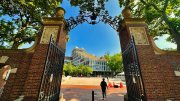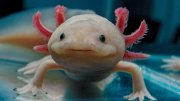How much federal research funding does Harvard receive?
Harvard received $686 million in federal research funding in fiscal year 2024—11 percent of its overall annual operating budget. Most came from the Department of Health and Human Services, which houses the National Institutes of Health (NIH), until recently the world’s largest public funder of biomedical research. At the T.H. Chan School of Public Health (HSPH), federal funding provides nearly half of the school’s annual budget.
What has been the effect of the funding freezes so far?
By June 5, the Trump administration had cut more than $2.2 billion in research funding, cancelling nearly 1,000 grants and contracts, spread across several years. The University is fighting these terminations in court, but the damage has already begun, says Gund professor of neurosciences and of molecular and cellular biology Sharad Ramanathan, who studies how stem cells give rise to complex tissues in the human embryo.
Ramanathan, who lost federal grants worth about $1.5 million per year, says that young scholars at Harvard are now looking for jobs abroad, and that he’s had to turn away undergraduates who ask about summer work in his lab. “Things are really worse than people think,” he says, comparing the threat to the demise of Bell Laboratories, the once-great powerhouse of physics research and technological inventions that dwindled into only a handful of scientists after Bell’s parent company, the AT&T monopoly, was broken up in 1984. “There is this point of no return,” Ramanathan says, “and that happens fairly quickly.”
How did Harvard and other universities come to rely on federal research funding?
The partnership between government and academia began after World War II, as a strategy to spur innovation and strengthen the country. Harvard President James Conant (who also helped organize the Manhattan Project) was an early proponent, as was Vannevar Bush, Ph.D. 1916, head of the U.S. Office of Scientific Research and Development, who submitted a 1945 report to U.S. President Harry Truman titled “Science—the Endless Frontier.” That same year, the NIH began making grants to universities and hospitals, and in 1950, the National Science Foundation (NSF) was formed. Soon, other federal departments and agencies began funding academic research as well, including NASA, the Department of Energy, and the Department of Defense.
What’s the difference between federally funded grants and contracts?
Both are awarded through a competitive process typically open to researchers across the country—only a fraction of applicants receive funding. Contracts are legally binding agreements about set deliverables or services, and the government exerts some oversight and control over the research. Grants are generally more flexible: the research is for a public purpose, but researchers have more freedom to adapt their investigations, leaving room for exploration and fortuitous discoveries.
Most federal funding for basic science and medical research is provided through grants. This research can’t simply be moved to the private sector—breakthroughs can take years of expensive trial and error, which for-profit biotech and pharmaceutical companies cannot afford. Federal grants typically last five years and can sometimes be renewed, enabling researchers to take bigger risks in the search for answers to difficult, important problems.
What are indirect cost reimbursements?
When a professor’s lab undertakes a government contract or grant, that takes resources away from other University priorities. The government on average has reimbursed about 60 percent of the overhead costs (such as salaries, equipment, and use of University-owned space) with Harvard picking up the remaining 40 percent. Now, the government says it will cap future reimbursements to institutions of higher education at 15 percent.
What is Harvard doing to cover the funding cuts?
In May, the University allocated $250 million to support campus research, on top of the $500 million it normally spends on research every year. The Faculty of Arts and Sciences (FAS) said that beginning in July, it would use its share of the funding to launch a program covering 80 percent of operating expenses for the terminated grants for tenure-track faculty members, and to cover tuition and stipends for FAS graduate students who had been funded through now-terminated grants.—The Editors
Click here to read comprehensive coverage of Harvard in the Crosshairs
Harvard’s 1,000 cancelled grants and contracts studied everything from space flight to sudden infant death. Here’s a sampling:
• Advanced tools for using ancient DNA to study biology and history ($1.91 million, NIH)
Researcher: David Reich, Harvard Medical School (HMS), Faculty of Arts and Sciences (FAS)
Subject: Developing tools for researchers studying ancient human DNA for insights into population history, biology, and disease
• Does neurotransmitter plasticity of para-serotonergic neurons augment autoresuscitation following perinatal stress and buffer SIDS risk? ($633,400, NIH)
Researcher: Susan Dymecki, HMS, FAS
Subject: Investigating the neurotransmitter serotonin’s potential role in sudden infant death syndrome (SIDS)
• The impacts of county-level COVID-19-related public health and social policies on racial/ethnic and socioeconomic disparities in mental health and healthcare utilization
($2.6 million, NIH)
Researcher: Rita Hamad, Harvard T.H. Chan School of Public Health (HSPH)
Subject: How pandemic-era policies—school and workplace closures and economic supports—affected mental health and psychological behaviors like smoking, alcohol consumption, and drug use in low-income and minority groups
• The longitudinal and dynamic effects of food insecurity on cognitive impairment and dementia risk ($389,420, NIH)
Researcher: Cindy Leung, HSPH
Subject: How the lack of reliable access to sufficient and healthy food during adulthood increases older Americans’ risk of cognitive impairment and dementia
• Long-term health consequences of birth by cesarean section ($610,794, NIH)
Researcher: Jorge Chavarro, HSPH, HMS
Subject: Investigating how C-section births increase lifelong risk of chronic conditions like obesity, type 2 diabetes, and cancer
• Modeling spaceflight-induced changes in blood cell formation and immune responses in human organ chips ($4 million, NASA funding, administered by the Biomedical Advanced Research and Development Authority, or BARDA)
Researcher: Don Ingber, HMS, Wyss Institute for Biologically Inspired Engineering, Paulson School of Engineering and Applied Sciences (SEAS)
Subject: A contract to build “organ chips”—microdevices lined with living cells—from the bone marrow of astronauts on the ARTEMIS II moon mission, to determine whether it’s possible to model the effects of low gravity and radiation exposure during spaceflight
• FlyBase: a Drosophila genomic and genetic database
($ 1.9 million, National Human Genome Research Institute)
Researcher: Norbert Perrimon, HMS, Howard Hughes Medical Institute
Subject: A grant to maintain FlyBase-Harvard, one of four pillars of a longstanding, worldwide database of genetic, genomic, and functional information from fruit fly studies
• Cognitive mechanisms of guided instruction in the early elementary years ($1.5 million, NSF)
Researcher: Elizabeth Bonawitz, Harvard Graduate School of Education (HGSE)
Subject: Studying whether traditional direct instruction or “guided query,” in which teachers engage students with questions (a method that has produced good results in brief lab settings), is more effective in teaching elementary school science
• Geometric deep learning to facilitate algorithmic and scientific advances in therapeutics ($566,128, NSF)
Researcher: Marinka Zitnik, HMS
Subject: Developing AI search engines to analyze vast datasets of molecules and proteins and find those with therapeutic value, potentially leading to quicker, cheaper drug discovery
• Programming multistable origami and kirigami structures via topological design ($6.25 million, Department of Defense)
Researcher: Katia Bertoldi, SEAS
Subject: A project to develop lightweight structures—from collapsible antennae to temporary bridges to field hospitals to bulletproof shields—that can change shape for different tasks or environments








